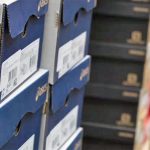Same-store sales in the U.S. rose 3.7% at Wal-Mart Stores Inc. Comps rose 3% at the Walmart chain and 7.3% at Sam’s Club. Excluding fuel, Sam’s Club’s comps rose 3%. At Walmart U.S., comps increased in grocery, entertainment and health and wellness. Although comps in home and apparel were slightly negative, the stores had much cleaner inventory in these areas and therefore, much less clearance than in the same period last year.
Wal-Mart’s total sales during July rose 9.4% to $30.2 billion. Sales rose 6.7% to $18.8 billion at Wal-Mart U.S., 7.7% to $3.5 billion at Sam’s Club and 17.1% to 30.2 billion at Wal-Mart International.
At Wal-Mart U.S., grocery was driven by strong sales in both food and consumables. Flat-panel televisions, video games, game accessories and digital media led the entertainment merchandise unit. Apparel was aided by strengths in juniors and new brands, including l.e.i. and Ocean Pacific. The home furnishings business led the home category, with strengths in ready-to-assemble furniture. The Canopy brand, introduced earlier this year, has been successfully integrated into the home offering and is performing well on-line and in stores.
The company saw momentum building in back-to-school and back-to-college offerings across the store and expects that momentum to carry through the August period. Customers are responding well to the “Do the math and save” messaging in advertising and in-store communications on products ranging from laptop computers to glue sticks.
“Walmart’s clear price leadership position continues to meet the needs of our customers in a difficult economy,” said Eduardo Castro-Wright, Walmart U.S. president and chief executive officer. “Better merchandise presentation, our everyday low price message and an improved store experience resonate with customers. With the end of the stimulus checks, we know consumers are spending more cautiously, and we continue to see a pronounced paycheck cycle at the end of the month. We also continue to see improvement in our customer traffic, relative to last year.”
Sam’s Club
Sales at Sam’s Club were driven by strengths in fresh food, dry grocery and consumables. Softness continued in house wares and residential furniture. Comparable club traffic and average ticket, excluding fuel, were higher for both Business and Advantage members.
“Small business continues to be the foundation of our growth,” said Doug McMillon, president and chief executive officer of Sam’s Club. “We continue to see inflationary pressures and were working to mitigate the impact wherever possible for our Business and Advantage members. While general merchandise sales are generally softer than in food, Sam’s Club members are responding to our focus on new items and new technology.”
Fuel sales continue to be a strong driver of top-line sales growth for Sam’s Club, with increases in both dollars and gallons sold.
Wal-Mart International
“We continue to be pleased with the sales results of our international businesses,” said Mike Duke, vice chairman, Wal-Mart International. “In our markets around the world, customers continue to see the value of our everyday low price offering and are responding to it with increased traffic at many of our formats.”
In the United Kingdom, ASDA delivered another strong sales performance, as sales grew in the high single digits. Core food categories continued to sell well because of strong customer traffic. Clothing sales strengthened in the month and outperformed a difficult market. Summer seasonal inventory was in good shape at the end of the month. Also during July, ASDA opened its sixth new food store this year, in Dalgety Bay, Scotland, and the store is performing ahead of expectations.
Wal-Mart Brazil delivered a very strong comparable store sales performance in July. Brazil‘s performance was led once again by the low price consumer format, Todo Dia, and the cash and carry format, Maxxi, as well as hypermarkets in the Southeast and supermarkets in the South.
Wal-Mart Canada delivered solid sales results, despite record rainfall that negatively affected some summer category sales. Two new supercentres were opened in July. The 36 Canadian supercentres continue to help strengthen food sales and overall market share.
In China, Wal-Mart celebrated the 12th anniversary of its entry in the country and featured rollbacks on more than 1,000 items. These rollbacks, as well as improved quality of fresh items, contributed to higher sales at the Wal-Mart supercenters. At the 100 Trust-Mart hypermarkets, there were positive increases in both customer count and average ticket. One Trust-Mart store remains closed from the May earthquake.
In Japan, comparable store sales declined slightly in July, although year-to-date comparable store sales remain positive. General merchandise comparable store sales were up for the month, as customers responded to everyday low price programs and seasonal merchandise. Apparel sales were negative, impacted by a planned reduction in promotional activity. Food categories have been a bright spot throughout the year, but registered mixed performance during the month of July. Customers are responding well to the introduction of private label food items.
Wal-Mart Mexico continues to have solid sales growth, with total sales in the low teens and comparable store sales in the mid-single digits, both in nominal terms. These results were driven by traffic in the self-service formats, Bodega, Supercenter, Sam’s Club and Superama. The Mexican consumer continues to be cautious, causing average ticket to suffer from dampened demand for high ticket items.
Guidance
“We believe our businesses are well positioned for the current economy,” said Tom Schoewe, executive vice president and chief financial officer. “We estimate U.S. comparable store sales, excluding fuel, for the August four-week period to be between one and two percent, because we still see sales volatility from week to week, especially around paycheck cycles.”















